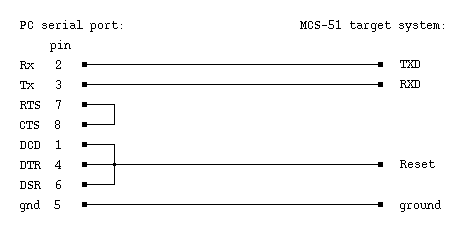II.3 Tailoring the Cables
Application programs are uploaded to the target system over a serial
interface. The serial ports of the PC may have

RS-232 cable with 25-pin female D-Shell connector
Shortening the modem control signals is absolutely required for batch
operation under
For shell script operation under Linux, only the Tx-, Rx-, and ground
lines are required, and the handshake inputs may be left open.
The same is true for interactive operation with most terminal emulation
programs. (For further information refer to the documentation of your
terminal emulation program.)
If there is a spare

RS-232 cable with 9-pin female D-Shell connector
If you own a
If your

Reset cable with 25-pin male D-Shell connector
In practice, only one of the two reset lines will be required.
When the reset program is invoked, a positive reset pulse appears
at D0 (8031, 8032), and a negative pulse at D1 (80C535, 80C537).
For detailed information on the reset program, refer to chapters